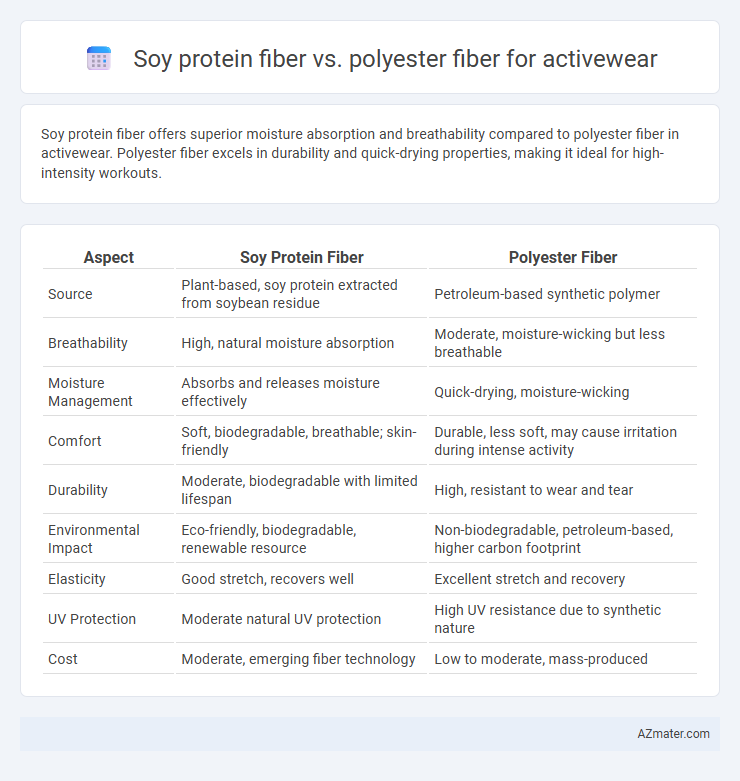Soy protein fiber offers superior moisture absorption and breathability compared to polyester fiber in activewear. Polyester fiber excels in durability and quick-drying properties, making it ideal for high-intensity workouts.
Table of Comparison
| Aspect | Soy Protein Fiber | Polyester Fiber |
|---|---|---|
| Source | Plant-based, soy protein extracted from soybean residue | Petroleum-based synthetic polymer |
| Breathability | High, natural moisture absorption | Moderate, moisture-wicking but less breathable |
| Moisture Management | Absorbs and releases moisture effectively | Quick-drying, moisture-wicking |
| Comfort | Soft, biodegradable, breathable; skin-friendly | Durable, less soft, may cause irritation during intense activity |
| Durability | Moderate, biodegradable with limited lifespan | High, resistant to wear and tear |
| Environmental Impact | Eco-friendly, biodegradable, renewable resource | Non-biodegradable, petroleum-based, higher carbon footprint |
| Elasticity | Good stretch, recovers well | Excellent stretch and recovery |
| UV Protection | Moderate natural UV protection | High UV resistance due to synthetic nature |
| Cost | Moderate, emerging fiber technology | Low to moderate, mass-produced |
Introduction to Soy Protein Fiber and Polyester Fiber
Soy protein fiber, derived from natural soybean protein, offers excellent moisture-wicking, breathability, and biodegradability, making it an eco-friendly option for activewear. Polyester fiber, a synthetic polymer widely used in sports apparel, provides durability, high tensile strength, and quick-drying properties essential for intense physical activities. Comparing these fibers highlights the balance between sustainability in soy protein fiber and the performance reliability of polyester fiber in activewear production.
Key Properties of Soy Protein Fiber
Soy protein fiber offers exceptional moisture absorption and breathability, making it ideal for activewear that demands comfort during intense workouts. The fiber is biodegradable, hypoallergenic, and provides excellent softness and elasticity, enhancing skin comfort and freedom of movement. Unlike polyester fiber, which is synthetic and less environmentally friendly, soy protein fiber supports sustainability while delivering natural temperature regulation and odor resistance.
Key Properties of Polyester Fiber
Polyester fiber offers exceptional moisture-wicking abilities, durability, and resistance to shrinking and stretching, making it ideal for activewear. Its high tensile strength and quick-drying properties provide comfort and long-lasting performance during intense physical activities. Unlike soy protein fiber, polyester is less prone to odor retention and maintains shape even after multiple washes.
Moisture Management and Breathability
Soy protein fiber exhibits superior moisture management by efficiently wicking sweat away from the skin, enhancing comfort during intense physical activity. Its natural porous structure promotes excellent breathability, allowing better air circulation compared to synthetic polyester fiber, which tends to trap heat and moisture. Polyester fiber, while durable and quick-drying, often lacks the natural breathability and moisture absorption properties inherent in soy protein fiber, making the latter a preferred choice for eco-friendly activewear.
Comfort and Skin-Friendliness
Soy protein fiber, derived from renewable plant sources, offers exceptional softness and breathability, making it highly comfortable for activewear. Its natural moisture-wicking properties and hypoallergenic nature enhance skin-friendliness by reducing irritation and promoting better air circulation during physical activities. In contrast, polyester fiber, while durable and moisture-resistant, often lacks the same level of softness and can trap heat and sweat, potentially causing discomfort and skin irritation during extended wear.
Durability and Performance in Activewear
Soy protein fiber offers excellent moisture absorption and breathability, making it comfortable for activewear, but it tends to be less durable under repeated stress and washing compared to polyester fiber. Polyester fiber provides superior durability with high resistance to abrasion, stretching, and shrinking, ensuring longer-lasting performance in activewear garments. The synthetic nature of polyester also enables quicker drying and better shape retention, which are crucial for maintaining activewear functionality during intense physical activities.
Sustainability and Environmental Impact
Soy protein fiber, derived from natural soybean polymers, offers biodegradability and a lower carbon footprint compared to polyester fiber, which is petroleum-based and non-biodegradable. The production of soy protein fiber consumes less water and energy, contributing to reduced environmental pollution and waste. Polyester fiber's reliance on fossil fuels and slow decomposition rate intensifies microplastic pollution, making soy protein fiber a more sustainable choice for activewear.
Cost and Market Availability
Soy protein fiber, derived from renewable plant-based sources, offers a sustainable alternative to traditional polyester fiber in activewear but typically comes at a higher production cost due to limited manufacturing infrastructure. Polyester fiber dominates the activewear market with widespread availability and lower raw material prices, driving cost efficiency for mass production. Market availability of soy protein fiber remains niche, targeting eco-conscious consumers, while polyester maintains a stronghold in global supply chains for performance apparel.
Innovations and Future Trends in Activewear Fabrics
Soy protein fiber, derived from renewable plant sources, is gaining traction in activewear due to its biodegradability, moisture-wicking properties, and natural softness, offering a sustainable alternative to polyester fiber. Innovations in blending soy protein with recycled polyester enhance durability and stretch, meeting performance demands while reducing environmental impact. Future trends emphasize bio-based, eco-friendly fabric technologies that combine the functionality of polyester with the comfort and sustainability of soy protein fibers, driving a shift toward greener activewear solutions.
Choosing the Right Fiber for Activewear: Comparative Summary
Soy protein fiber offers superior moisture-wicking and biodegradability compared to polyester fiber, making it ideal for sustainable activewear. Polyester fiber excels in durability, elasticity, and quick-drying properties, providing better support and shape retention during intense workouts. Choosing between soy protein and polyester fibers depends on prioritizing eco-friendliness and comfort versus performance and longevity in activewear fabric.

Infographic: Soy protein fiber vs Polyester fiber for Activewear
 azmater.com
azmater.com